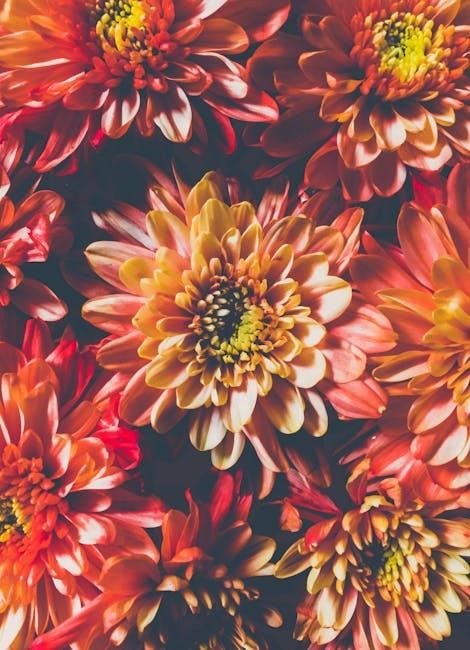Flowers captivate with their vibrant colors, each carrying unique meanings and emotions. This guide explores the significance of flower hues, helping you choose the perfect blooms for any occasion.
Overview of Flower Colors and Their Significance
Flower colors create a vibrant spectrum, each hue carrying distinct meanings. Red symbolizes love, while white represents purity. Yellow reflects happiness, and purple embodies luxury. These colors convey emotions, celebrate occasions, and honor traditions, making them a powerful language in floral arrangements and gestures, deeply influencing human connections and memories.
Importance of Color in Flower Selection for Occasions and Emotions
Color plays a crucial role in selecting flowers for specific occasions and emotions. Red roses express romantic love, while white lilies symbolize sympathy. Yellow sunflowers convey gratitude, and pink carnations represent appreciation. Understanding these color meanings ensures thoughtful and impactful choices, making flowers a universal language of emotion and celebration across cultures and traditions.
Role of Color in Floral Design and Arrangements
In floral design, color harmonizes emotions and aesthetics, guiding arrangement themes. Contrasting hues like red and purple create drama, while pastels evoke softness. Seasonal palettes enhance visual appeal, ensuring each piece tells a story. Color balance is key to crafting arrangements that resonate with their intended mood and environment, making them truly unforgettable.
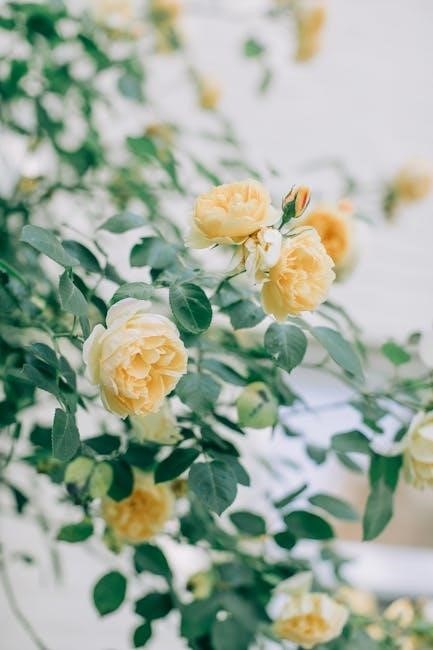
Red Flowers
Red flowers symbolize passion, love, and romance, making them a timeless choice for expressing deep emotions and celebrating life’s special moments with vibrant beauty and intensity.
Symbolism and Meaning of Red Flowers
Red flowers embody profound emotions, symbolizing love, passion, and romance. They often represent deep affection, desire, and heartfelt connections. In various cultures, red blooms are also linked to courage, respect, and celebration, making them a classic choice for expressing love and admiration in meaningful ways.
Popular Types of Red Flowers (Roses, Tulips, Poppies)
Roses are the quintessential red flower, symbolizing love and romance. Tulips, with their cup-shaped blooms, represent passionate declarations. Poppies, known for their delicate yet vibrant red petals, often signify remembrance and resilience. Each variety brings its own unique charm and emotional depth to arrangements and gardens alike.
Best Occasions for Red Flowers (Valentine’s Day, Weddings, Anniversaries)
Red flowers are perfect for expressing deep emotions. Valentine’s Day calls for roses to convey love. Weddings often feature red blooms for passion and commitment. Anniversaries are celebrated with red tulips or poppies, symbolizing enduring affection. These occasions are elevated by the bold, heartfelt beauty of red flowers, making them unforgettable gestures.
Pink Flowers
Pink flowers symbolize love, gratitude, and friendship, offering a delicate alternative to red. Their soft hues create charming arrangements for celebrations, expressing warmth and gentle emotions beautifully.
Significance and Variations of Pink Flower Shades
Pink flowers come in various shades, each with distinct meanings. Light pink symbolizes tenderness and innocence, while hot pink represents passion and energy. Pastel pinks convey softness and vulnerability, making them ideal for expressing subtle emotions and creating delicate, charming arrangements for numerous occasions.
Popular Pink Flowers (Carnations, Roses, Camellias)
Carnations, roses, and camellias are beloved for their stunning pink hues. Carnations offer long-lasting beauty in various pink tones, while roses symbolize love and romance. Camellias, with their elegant blooms, add sophistication to any setting, making these flowers perfect for expressing affection, gratitude, and timeless elegance in floral arrangements.
Using Pink Flowers for Expressing Love, Gratitude, and Friendship
Pink flowers are a heartfelt way to convey love, gratitude, and friendship. Lighter shades like pastel pink express soft emotions, while brighter tones symbolize joy and appreciation. These blooms are perfect for celebrating friendships, acknowledging support, or showing love in a delicate, warm manner, making them versatile for various meaningful occasions.
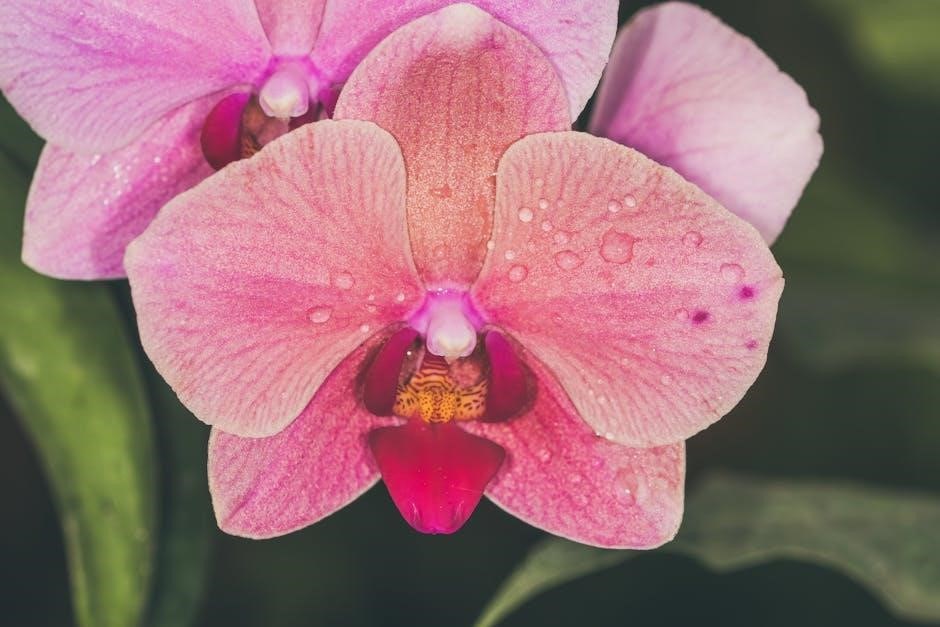
White Flowers
White flowers symbolize purity, innocence, and reverence, making them ideal for weddings and memorials. Their clean, elegant appearance evokes peace and sincerity, transcending cultural boundaries.
Meaning of White Flowers in Different Contexts (Purity, Innocence, Sympathy)
White flowers embody purity, innocence, and reverence, often used in weddings and religious ceremonies. They symbolize new beginnings and spiritual growth. In sympathy, white blooms express condolences and hope, while their clean aesthetic represents peace and sincerity across cultures and occasions.
Popular White Blooms (Lilies, Gardenias, Orchids)
Lilies symbolize purity and refined elegance, often used in weddings and sympathy arrangements. Gardenias, with their creamy petals and intoxicating fragrance, add sophistication to any setting. Orchids, known for their timeless beauty, represent love and luxury, making them a versatile choice for both modern and traditional floral designs.
White Flowers in Weddings and Funeral Arrangements
White flowers are timeless in weddings, symbolizing purity and unity, often featured in bouquets and centerpieces. In funerals, they represent respect and condolences, commonly used in wreaths and arrangements to honor loved ones, conveying peace and hope during solemn occasions.
Yellow Flowers
Yellow flowers symbolize happiness, hope, and optimism. They brighten celebrations and get-well wishes. Popular types include sunflowers, daffodils, and tulips.
Yellow as a Symbol of Happiness, Hope, and Optimism
Yellow flowers embody warmth and positivity, symbolizing joy, hope, and renewal. They evoke feelings of sunshine and optimism, making them ideal for celebrations and get-well wishes, spreading cheer and uplifting spirits.
Common Yellow Flowers (Sunflowers, Daffodils, Tulips)
Sunflowers, with their bright faces, represent loyalty and warmth. Daffodils symbolize new beginnings, while tulips convey hope and happiness. These vibrant blooms are popular for their cheerful hues and versatility in arrangements, bringing joy to any setting with their radiant yellow petals.
Yellow Flowers for Celebrations and Get-Well Wishes
Yellow flowers are ideal for celebrating milestones and lifting spirits. Sunflowers and daffodils bring optimism, while tulips and daisies offer warmth. Their bright hues convey hope, renewal, and joy, making them perfect for birthdays, graduations, and get-well gestures, spreading positivity and cheer to loved ones.
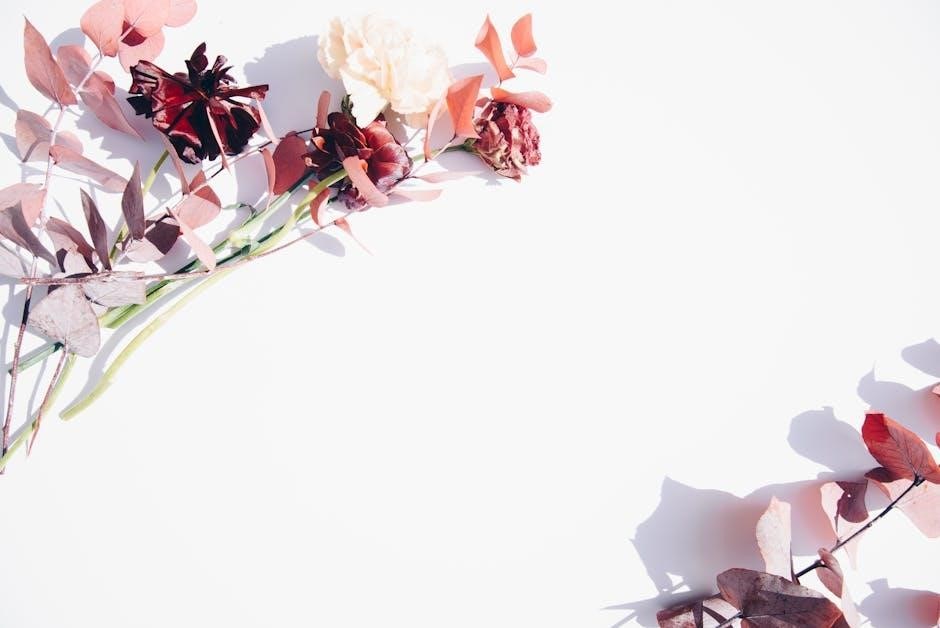
Orange Flowers
Orange flowers symbolize enthusiasm, energy, and success, adding vibrant warmth to arrangements. Popular varieties include nasturtiums, marigolds, and gerbera daisies, perfect for creating lively, dynamic displays.
Orange Color Symbolism (Enthusiasm, Energy, Success)
Orange flowers embody enthusiasm, energy, and success, radiating warmth and vitality. Their vibrant tones evoke feelings of optimism and joy, making them ideal for celebrating achievements or expressing vibrant, lively emotions in arrangements and gardens alike.
Popular Orange Blooms (Nasturtiums, Marigolds, Gerbera Daisies)
Nasturtiums, Marigolds, and Gerbera Daisies are stunning orange blooms. Nasturtiums add delicate, crepe-paper-like petals, Marigolds offer bright, sunny bursts, and Gerbera Daisies provide bold, cheerful flowers. Each brings vibrant energy, perfect for adding warmth and vitality to any arrangement or garden.
Using Orange Flowers for Vibrant and Energetic Arrangements
Orange flowers like Nasturtiums, Marigolds, and Gerbera Daisies create lively, dynamic arrangements. Their bold hues add excitement to any setting, blending seamlessly with complementary colors like yellow, pink, and purple. Use them as focal points or accents to infuse energy and warmth, making your designs stand out with their vibrant, sunny appeal.
Purple Flowers
Purple flowers embody luxury, royalty, and wisdom, adding richness and depth to arrangements. Their regal tones create striking contrasts, making them perfect for adding drama and elegance to gardens and designs.
Meaning of Purple in Flowers (Luxury, Royalty, Wisdom)
Purple flowers symbolize luxury, royalty, and wisdom, evoking grandeur and sophistication. Historically, purple was a rare color, reserved for kings and queens. In modern times, it’s used to convey admiration, creativity, and elegance, making it a popular choice for expressing gratitude and celebrating milestones with refinement and poise.
Popular Purple Flowers (Lilacs, Orchids, Hydrangeas)
Lilacs are known for their fragrant blooms and purple hues, symbolizing nostalgia. Orchids, with their delicate beauty, represent elegance and refinement. Hydrangeas offer striking purple clusters, often used in grand floral arrangements. These flowers add a touch of sophistication and charm to any setting, making them timeless favorites in floral design.
Adding Contrast and Drama with Purple Blooms in Gardens
Purple flowers create striking contrasts, enhancing garden visual appeal. Pairing rich purple lilacs or hydrangeas with green foliage or yellow blooms adds drama. Orchids bring elegance, while verbena offers vibrant, long-lasting color. These flowers draw attention, balancing bold and subtle elements for a dynamic, eye-catching garden display that captivates throughout the growing season.
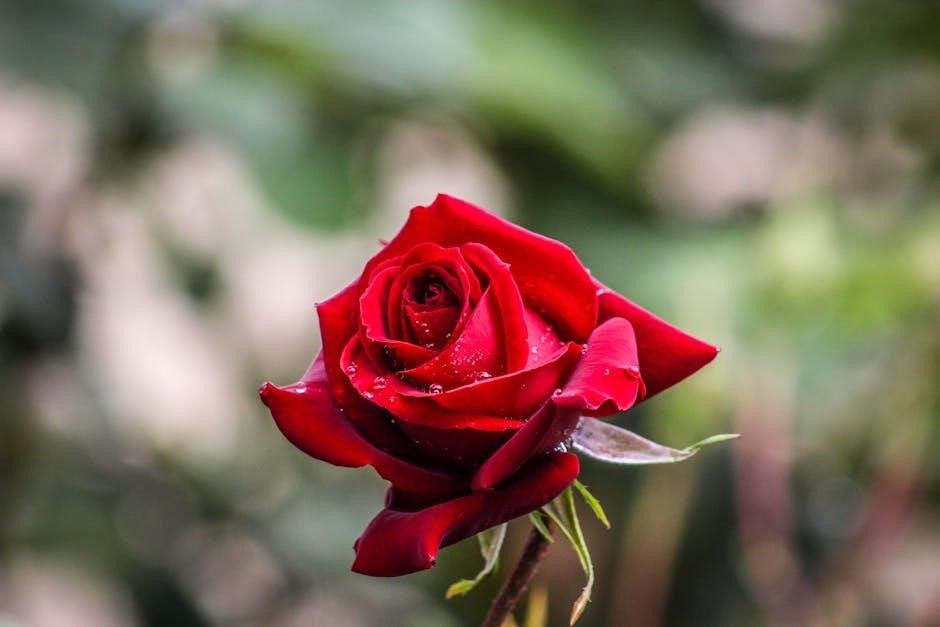
Blue Flowers
Blue flowers, though rare, symbolize tranquility and trust. Popular varieties include forget-me-nots, cornflowers, and hydrangeas, each offering a soothing presence in gardens and arrangements.
Rarity and Significance of Blue Flowers
Blue flowers are rare in nature, symbolizing trust, loyalty, and peace. Their scarcity adds to their allure, making them highly sought after for their calming and serene beauty in arrangements.
Popular Blue Blooms (Forget-Me-Nots, Cornflowers, Hydrangeas)
Forget-me-nots, with their delicate blue petals, symbolize remembrance. Cornflowers, vibrant and tall, add charm to bouquets. Hydrangeas, in soft blue clusters, bring elegance to arrangements, making these blooms timeless favorites for their beauty and emotional resonance.
Using Blue Flowers for Calming and Soothing Effects
Blue flowers create serene environments, their cool tones evoking tranquility. Ideal for relaxation, they bring a soothing ambiance to spaces, making them perfect for wellness designs and calming floral arrangements that promote peace and harmony.
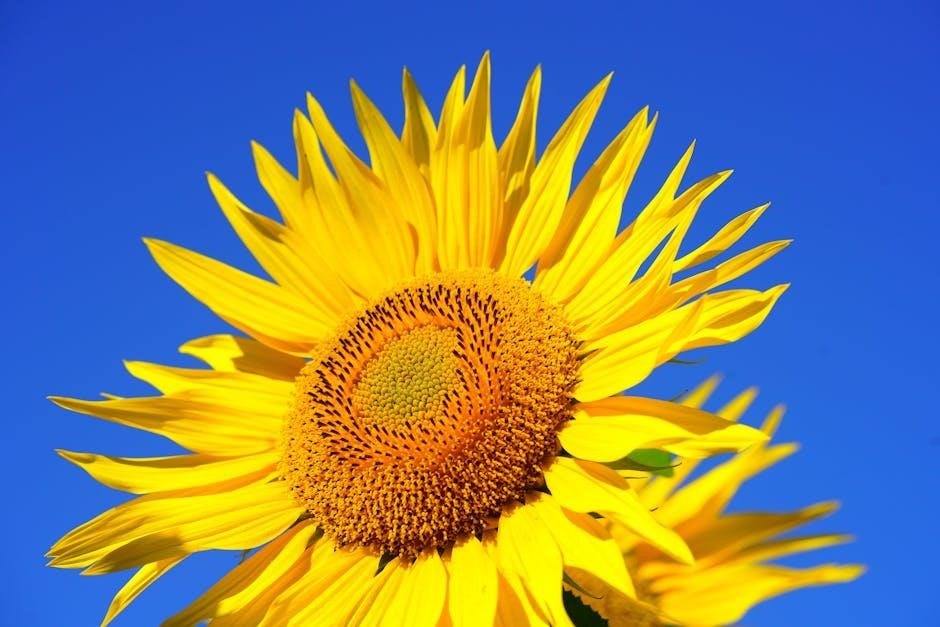
Green Flowers
Green flowers, like orchids and bells of Ireland, offer a fresh, natural look, adding uniqueness to arrangements with their calming tones and versatile appeal in gardens and designs.
Unique Appeal of Green Flowers
Green flowers, such as orchids and bells of Ireland, offer a fresh, natural beauty that stands out in arrangements. Their calming tones symbolize harmony, growth, and renewal, adding a unique twist to traditional blooms while complementing other colors effortlessly in both gardens and modern designs.
Popular Green Blooms (Orchids, Bells of Ireland, Eucalyptus)
Orchids captivate with their delicate, exotic shapes and vibrant green hues. Bells of Ireland charm with their unique, bell-shaped blooms. Eucalyptus adds freshness with its silvery-green leaves, often used in arrangements for its aromatic scent and versatile texture, making these green blooms a stunning addition to any floral design.
Incorporating Green Flowers into Modern Arrangements
Green flowers bring a fresh, natural aesthetic to modern designs. Pair orchids with white blooms for a sleek look or use Bells of Ireland as a statement piece. Eucalyptus adds a fragrant, earthy element, blending seamlessly with vibrant colors to create balanced, contemporary arrangements that evoke harmony and elegance.
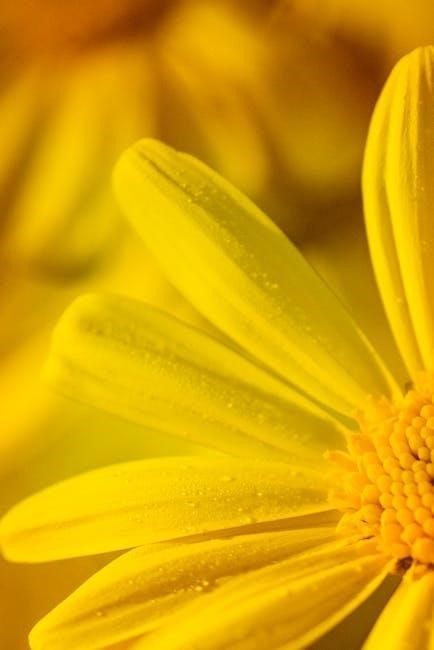
Combining Flower Colors for Visual Impact
Strategic color blending enhances floral arrangements, creating harmony or contrast. Pair warm tones like red and orange for energy, or cool shades like blue and purple for calm.
Color Combinations for Different Themes and Effects
Harmonious mixes like soft pinks with whites create romantic themes, while vibrant yellows and oranges evoke celebration. Contrasting schemes, such as red and purple, add drama, perfect for bold statements. Seasonal palettes, like autumnal reds and oranges, bring warmth, ensuring each arrangement tells a unique story through color.
Harmonious and Contrasting Color Schemes in Floral Design
Harmonious schemes blend complementary tones, like soft pinks with whites, for a cohesive look. Contrasting schemes, such as bold reds paired with deep purples, create visual drama. Balancing warm and cool hues ensures arrangements are visually appealing without clashing, allowing each flower to shine while contributing to the overall aesthetic harmony.
Seasonal Color Palettes for Year-Round Beauty
Seasonal palettes offer fresh inspiration, with spring featuring pastel hues like soft pinks and yellows. Summer blooms with vibrant oranges and purples, while autumn highlights warm reds and golden yellows. Winter brings icy whites and deep blues, creating a dynamic rotation of colors that reflect nature’s ever-changing beauty throughout the year.
Thank you for joining this journey through the vibrant world of flower colors. Each hue carries unique meanings, offering endless ways to express emotions and celebrate life’s moments beautifully.
Final Thoughts on the Importance of Flower Colors
Flower colors are more than just aesthetics; they convey emotions, celebrate occasions, and add depth to floral designs. Understanding their meanings allows for thoughtful expression, making each bouquet or arrangement a meaningful and personalized gesture. This guide highlights the significance of leveraging color symbolism to create lasting impressions in every floral choice.
Encouragement to Explore and Experiment with Floral Colors
Embrace the world of floral colors with curiosity and creativity! Experimenting with different hues and combinations can unlock new ways to express emotions and celebrate occasions. Don’t hesitate to mix shades and styles to craft unique arrangements that reflect your personality and inspire others. Let flowers be your canvas for endless expression.
